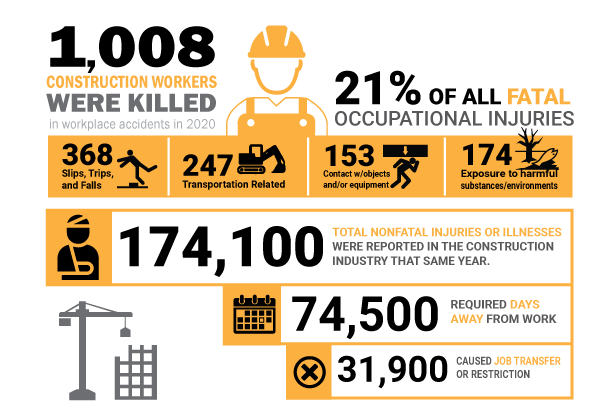Safety You Can See, Successful Construction Communication
13
July,
2023
2 MINUTE READ

1,008 construction workers were killed in workplace accidents in 2020, 21% of all fatal occupational injuries.
- 368 from slips, trips, and falls
- 247 transportation related
- 153 from contact with objects and/or equipment
- 174 caused by exposure to harmful substances or environments.
174,100 total nonfatal injuries or illnesses were reported in the construction industry that same year.
- 74,500 required days away from work,
- 31,900 caused job transfer or restriction
Visual safety communication is one of the most effective ways to identify the hazards and risks associated with the construction industry. Here are 5 ways to use visual communication to improve construction safety.

1. Communicate instantly.
Safety can't wait. Time is money on the job site, and the work needs to get done quickly. Make sure workers have the information they need to avoid incidents without slowing down the job.
- Visual communication is a universal language that can be understood by all workers.
- Workers are more likely to remember a visual than a written message.
- Communicate changes in the work environment, such as closed areas, temporary hazards, or equipment in use.
2. Improve safety training.
Eighty percent of human learning is through processing visual information. The use of images, charts, graphs, and diagrams to communicate safety messages is the most effective way to capture the attention of workers and help them understand the risks associated with their work environment. When workers understand the hazards, they are better equipped to avoid incidents.
3. Use the right tools.
Safety signs, labels, and other visual cues are the best way to convey safety messages.
- Floor marking lines to indicate safe walking paths or equipment zones.
- Posters or banners that use images and text to communicate safety messages.
- Floor signs to indicate hazardous areas or required PPE.
- Labels to identify hazardous materials or areas.
- Instructional videos or animations that demonstrate proper safety procedures.
4. Keep up with regulations.
OSHA regulations are designed to keep workers safe. Some of the most frequently cited violations are hazard communication, PPE deployment, and work zone traffic control. Signage helps workers identify hazards, follow safety procedures, and avoid dangerous conditions. Post signs and labels in prominent locations such as entrances and exits, near heavy equipment, or at the entrance to confined spaces.
5. Make it simple.
Visuals should be simple, clear, and concise, with minimal text. They should be consistent with industry standards and reflect the company's safety culture. Use colors that contrast with the environment, such as black and yellow, to help the message stand out. Train workers to ensure that they understand the purpose and meaning of the safety messages.
Put it to work
Promote safety awareness and reduce the risk of accidents, injuries, and illnesses by implementing visual safety communication. Use signs, labels, and floor marking to communicate hazards and reinforce safety messaging. Upgrade safety training with visual tools to improve retention and decrease common injuries.
Need help? Get expert guidance for your visual safety needs by scheduling a free visual safety consultation.
RELATED RESOURCES

9 Tips for Effective Safety Messaging to Prevent Common Injuries
Organizations are required under the OSHA General Duty clause to provide a working environment "free from ...
Read
Building a Safer Work Environment: 5 Powerful Benefits of Safety Training
There are 12,900 worker-related injuries every day, according to the National Safety Council, and this ...
Read
Watch Out: 3 Simple Tips to Prevent Brain Injuries
According to the Brain Injury Association, each year 2.8 million people sustain a workplace-related brain ...
Read.png)


